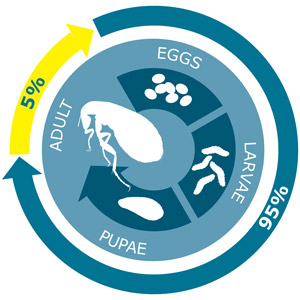
Fascinating Fleas

Fleas are the most common visible parasite affecting cats and dogs. They are a year-round problem and can also transmit tapeworms to your pets. If uncontrolled, flea numbers can grow rapidly.
|
1 flea can become 1,000 in just 21 days |
The most common flea we see can survive on both dogs and cats - but luckily not humans. Fleas are hard to spot so just because you’ve not seen one on your pet, it doesn’t mean that they’re not there. Irritating to humans and pets, fleas feed on the blood of their host and can be a trigger for allergic skin disease. This can lead to redness, itching, pain and infection, particularly at the base of the tail, groin area and along the stomach.
Fleas can survive both within our homes and in the outdoors environment so a year-round prevention regime is vital.
|
Some species of flea can jump more than 200 times their height. That’s equivalent to an adult human being capable of jumping over the Eiffel Tower! |
How do fleas affect people?
Fleas can occasionally bite people causing localised itching, redness and soreness. The most common site for bites is around the feet and legs, these being the most accessible parts available to newly hatched fleas as they emerge from a pupae lodged in the carpet.
Cat Scratch Fever is a bacterial zoonotic disease carried by fleas and can be found in around 40% of cats at some point in their lives. People with weak immune systems are at increased risk of getting seriously ill with cat scratch fever. The key to preventing cat scratch fever is to practise excellent flea control and avoid cat scratches or bites.
|
50% of fleas have been found to carry at least one disease! |
The 4-stage flea life cycle
Fleas have a 4-stage life cycle and the fleas you might see on your pet will be just the tip of the iceberg. 95% of the flea’s life cycle occurs in the environment - this can mean in our homes, gardens and outdoor spaces. Adult fleas live on your pet but represent only 5% of the total flea population.
EGGS On average a female flea lays 50 eggs a day on untreated pets which scatter as your pet moves around their home: into carpets, pet bedding and soft furnishings, under skirting and floorboards and even in your car.
ADULT FLEAS live on your pet, feeding on their blood.
FLEA LARVAE hatch from eggs and feed on organic matter, such as skin scales and dandruff. They like the dark so burrow deep into carpets, upholstery and underneath floorboards.
PUPAE are sticky, impenetrable cocoons from which adult fleas hatch. Hatching is triggered by warmth, humidity and vibrations caused by passing pets or people. While pupae can hatch after as little as one week, they can lie dormant in cracks and crevices for up to a year, only hatching when conditions are right.




